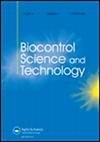利用野外试验预测德克萨斯瘦蚁的实现寄主范围
IF 1.2
4区 农林科学
Q4 BIOTECHNOLOGY & APPLIED MICROBIOLOGY
引用次数: 0
摘要
摘要:德克萨斯瘦甲是一种潜在的防治澳大利亚银叶茄的生物防治剂。然而,以往的研究表明,在检疫笼实验中,德州镰刀菌可以在非目标作物茄上生长。我们在美国德克萨斯州的原生地进行了露天试验,以澄清德克萨斯L. texana与S. melongena之间的实际宿主范围。我们进行了5个重复的野外实验,以研究:(1)在开阔的野外环境中,当同时存在黑桫椤和黑桫椤时,德克萨斯夜蛾对产卵的偏好程度;(2)幼虫从脱落的黑桫椤转移到附近的黑桫椤植物上,或绕过黑桫椤寻找黑桫椤的程度。在野外实验中,我们发现成虫在定居和产卵时更倾向于花楸而不是其他植物,事实上,在所有实验中都没有观察到花楸产卵。然而,在实验植物(对照)中观察到的低产卵水平不足以最终证明黑绒棉不在德克萨斯棉蚜成虫的实际寄主范围内。我们还发现有证据表明,在共生的松叶松叶松脱落的情况下,德克萨斯松叶松的幼虫会对松叶松造成溢出损害。最后,我们演示了使用参数图来直观地表示多个(有时相互冲突的)现场和实验室实验对生物防治剂风险分析的贡献。本文章由计算机程序翻译,如有差异,请以英文原文为准。
Predicting the realised host-range of Leptinotarsa texana with open-field experiments
ABSTRACT The leaf beetle Leptinotarsa texana is a potential biological control agent for silverleaf nightshade Solanum elaeagnifolium in Australia. However, previous research has shown that L. texana can develop on the non-target crop eggplant Solanum melongena in quarantine cage experiments. We used open-field experiments in the agent's native range of Texas, USA, to clarify the realised host-range of L. texana in relation to S. melongena. We conducted five replicated field experiments to investigate: (1) the extent that L. texana would show a preference for oviposition when presented with both S. elaeagnifolium and S. melongena in an open-field context, and (2) the extent that larvae would move from defoliated S. elaeagnifolium onto either nearby S. melongena plants, or bypass S. melongena in search of S. elaeagnifolium. We found, in the open-field experiments, that adult females prefer S. elaeagnifolium over S. melongena plants for settling and oviposition and, in fact, observed no oviposition on S. melongena in any experiment. However, the low levels of oviposition observed in the S. elaeagnifolium experimental plants (the control) was insufficient to conclusively demonstrate that S. melongena is not within the realised host-range of L. texana adults. We also found evidence that L. texana larvae can cause spill-over damage to S. melongena in situations where co-occurring S. elaeagnifolium is defoliated. Finally, we demonstrate the use of an argument map to visually represent the contributions of multiple, sometimes conflicting, field and laboratory experiments to biological control agent risk analysis.
求助全文
通过发布文献求助,成功后即可免费获取论文全文。
去求助
来源期刊
CiteScore
3.20
自引率
7.10%
发文量
64
审稿时长
4-8 weeks
期刊介绍:
Biocontrol Science and Technology presents original research and reviews in the fields of biological pest, disease and weed control. The journal covers the following areas:
Animal pest control by natural enemies
Biocontrol of plant diseases
Weed biocontrol
''Classical'' biocontrol
Augmentative releases of natural enemies
Quality control of beneficial organisms
Microbial pesticides
Properties of biocontrol agents, modes of actions and methods of application
Physiology and behaviour of biocontrol agents and their interaction with hosts
Pest and natural enemy dynamics, and simulation modelling
Genetic improvement of natural enemies including genetic manipulation
Natural enemy production, formulation, distribution and release methods
Environmental impact studies
Releases of selected and/or genetically manipulated organisms
Safety testing
The role of biocontrol methods in integrated crop protection
Conservation and enhancement of natural enemy populations
Effects of pesticides on biocontrol organisms
Biocontrol legislation and policy, registration and commercialization.

 求助内容:
求助内容: 应助结果提醒方式:
应助结果提醒方式:


